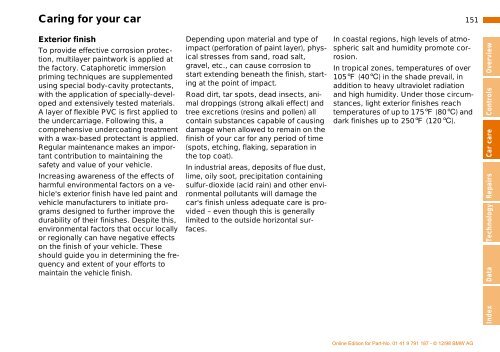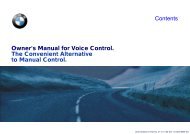Owner's Manual for the vehicle. With a quick reference ... - E38.org
Owner's Manual for the vehicle. With a quick reference ... - E38.org
Owner's Manual for the vehicle. With a quick reference ... - E38.org
Create successful ePaper yourself
Turn your PDF publications into a flip-book with our unique Google optimized e-Paper software.
Caring <strong>for</strong> your car<br />
151n<br />
Exterior finish<br />
To provide effective corrosion protection,<br />
multilayer paintwork is applied at<br />
<strong>the</strong> factory. Cataphoretic immersion<br />
priming techniques are supplemented<br />
using special body-cavity protectants,<br />
with <strong>the</strong> application of specially-developed<br />
and extensively tested materials.<br />
A layer of flexible PVC is first applied to<br />
<strong>the</strong> undercarriage. Following this, a<br />
comprehensive undercoating treatment<br />
with a wax-based protectant is applied.<br />
Regular maintenance makes an important<br />
contribution to maintaining <strong>the</strong><br />
safety and value of your <strong>vehicle</strong>.<br />
Increasing awareness of <strong>the</strong> effects of<br />
harmful environmental factors on a <strong>vehicle</strong>'s<br />
exterior finish have led paint and<br />
<strong>vehicle</strong> manufacturers to initiate programs<br />
designed to fur<strong>the</strong>r improve <strong>the</strong><br />
durability of <strong>the</strong>ir finishes. Despite this,<br />
environmental factors that occur locally<br />
or regionally can have negative effects<br />
on <strong>the</strong> finish of your <strong>vehicle</strong>. These<br />
should guide you in determining <strong>the</strong> frequency<br />
and extent of your ef<strong>for</strong>ts to<br />
maintain <strong>the</strong> <strong>vehicle</strong> finish.<br />
Depending upon material and type of<br />
impact (per<strong>for</strong>ation of paint layer), physical<br />
stresses from sand, road salt,<br />
gravel, etc., can cause corrosion to<br />
start extending beneath <strong>the</strong> finish, starting<br />
at <strong>the</strong> point of impact.<br />
Road dirt, tar spots, dead insects, animal<br />
droppings (strong alkali effect) and<br />
tree excretions (resins and pollen) all<br />
contain substances capable of causing<br />
damage when allowed to remain on <strong>the</strong><br />
finish of your car <strong>for</strong> any period of time<br />
(spots, etching, flaking, separation in<br />
<strong>the</strong> top coat).<br />
In industrial areas, deposits of flue dust,<br />
lime, oily soot, precipitation containing<br />
sulfur-dioxide (acid rain) and o<strong>the</strong>r environmental<br />
pollutants will damage <strong>the</strong><br />
car's finish unless adequate care is provided<br />
– even though this is generally<br />
limited to <strong>the</strong> outside horizontal surfaces.<br />
In coastal regions, high levels of atmospheric<br />
salt and humidity promote corrosion.<br />
In tropical zones, temperatures of over<br />
1057 (406) in <strong>the</strong> shade prevail, in<br />
addition to heavy ultraviolet radiation<br />
and high humidity. Under those circumstances,<br />
light exterior finishes reach<br />
temperatures of up to 1757 (806) and<br />
dark finishes up to 2507 (1206).<br />
Index Data Technology Repairs Car care Controls Overview



